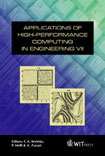On Parallel Computing For The General Boundary Element Method
Price
Free (open access)
Volume
27
Pages
Published
2002
Size
290 kb
Paper DOI
10.2495/HPC020091
Copyright
WIT Press
Author(s)
X. Y. Zhao & S. J. Liao
Abstract
Liao [2-51 proposed a so-called general boundary element method, which is valid for nearly all nonlinear differential equations, especially those with strong non- linearity. However, it is well known that, domain integral appears when the BEM is employed to solve a nonlinear problem, which considerably increases the CPU time. In this paper, we propose a parallel general boundary element method. To show its validity, our approach is applied to the viscous flow in a driven square cavity, and we obtain the convergent numerical results even at quite high Reynolds number Re = 7500. 1 Introduction It is well known that BEM often fails to give convergent numerical results of highly nonlinear problems. For example, although the problem of the viscous flow in a driven square cavity at high Reynolds number has been solved by lot of numerical techniques such as FDM, FVM and so on, to the best of our knowledge, no one (see [1]) has successfully employed BEM to give convergent result at a high Reynolds number such as Re = 7500. This is mainly because
Keywords




